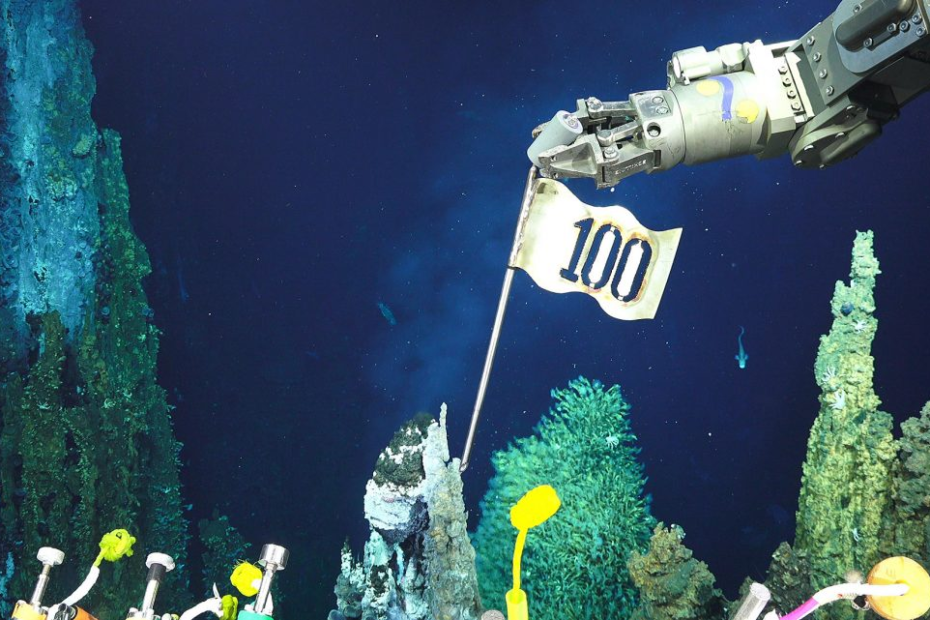Most of Earth’s volcanoes are in the oceans, yet scientists know very little about them compared to volcanoes on land.
The core goal of this expedition was to understand more about submarine volcanic activity, as well as their impacts on ocean chemistry and ecosystems.
By scrutinizing the geological and magmatic evolution of each volcano as a single individual – then studying all of them as a group – researchers are developing a stronger understanding of volcano history, volcanic eruption styles, and how submarine volcanoes grown over time.
Additionally, the relationship of volcanic activity to magma generation in the mantle below – across a wide array of volcanic settings – was an important focus.
By approaching with a multidisciplinary team, researchers investigated many aspects of submarine volcanism, studying how geological, biological, and chemical processes interact at these seamounts.
Vent biology, fluid chemistry, and chimney sampling were also components of the research, ingredients to uncode the relationships between volcanoes and hydrothermal vent ecosystems.
“Submarine volcanism is one of the fundamental processes that has affected both the composition of our oceans and the shape of the seabed, as well as the development of life on our planet,” said Ken Rubin, Principal Investigator and Professor at the School of Ocean and Earth Science and Technology (SOEST), University of Hawai‘i.
“It is hard to pick the most exciting things that we have learned on this expedition because we have learned so much.
“However, perhaps the top four are the number of recent eruptions in the area, the amount of deep sea explosive volcanic deposits, the wide range of volcanic styles on small, closely-spaced volcanoes, and the number and diversity of hydrothermal systems and habitats in the area.”
Although these volcanoes are very closely-spaced (their bases are just 0.6 km apart on average), the stark volcanic differences between them were key findings.
Four of the volcanoes have active hydrothermal systems (and another has an inactive site), but the style of the hydrothermal activity, the shapes and spacing of the chimneys, their heights and the biological communities living among them are all very different from site to site.
Researchers discovered that recent volcanic eruptions are not restricted to the summits of the Mata volcanoes – several have been active at their flanks and bases.
One of these eruptions started as a very unusual intrusion into sediment, pushing up and blistering the sea floor, followed by lava oozing out of the base of this uplift mound. These various eruption styles and locations provide new insights into the magma plumbing systems of the volcanoes and how they grow over time.
The team also recorded an unexpectedly large range of lava types (both slow and fast moving), and interior textures of lava rocks recovered (including the numbers, shapes and sizes of crystals and frozen gas bubbles known as vesicles).
These lava rock samples provide important clues about the wide variety of eruption styles at these volcanoes.
The team was able to closely observe dacite lava flows in two sites that are enormous in area and volume, with flow lengths up to 10 km.
These are the largest known dacite lava flows on the planet. Some of the flows do not seem to be associated with any obvious volcano, which is puzzling for flows of this size.
Researchers determined the eruptions that created these huge dacite lava flows likely included an explosive phase. This is a surprising finding, striking to see in the deep ocean: the force needed to produce explosive activity under the pressure of more than two kilometers of water is massive.
Millions of viewers watched daily as the expedition broadcast livestreams of the dives over YouTube and Facebook.
The live video was captured by Remotely Operated Vehicle SuBastian at depths of up to 2,900 meters (1.8 miles), then fed to the ship by way of a cable tether before being shared worldwide via a satellite internet connection.
Accomplishments of the expedition include:
- 21 ROV dives at 11 Submarine volcanoes
- 250+ Lava samples
- 40 volcanic sediment samples
- 30+ Sulfide samples
- 60+ Vent fluid samples
- 470+ Biological samples
- 12,000+ km2 of seafloor mapped
This expedition was a partnership between Schmidt Ocean Institute, the University of Hawaii’s Department of Geology and Geophysics in the School of Ocean and Earth Science and Technology, NOAA’s Earth-Ocean Interactions Program at the Pacific Marine Environmental laboratory, plus other international partners.
